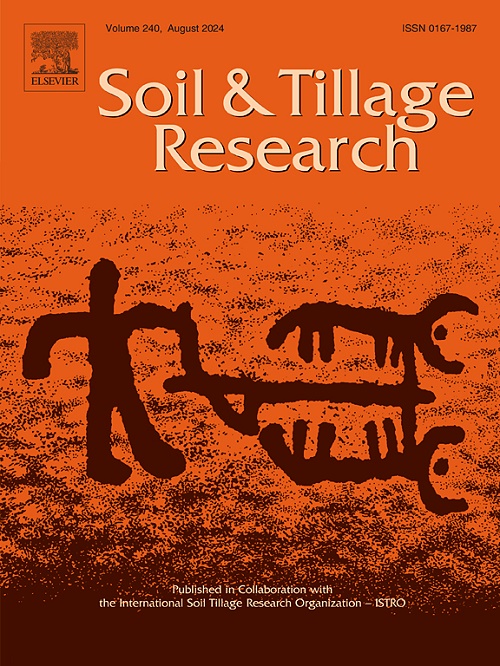Mapping soil organic carbon sequestration potential in croplands using a combined proximal and remote sensing approach
IF 6.8
1区 农林科学
Q1 SOIL SCIENCE
引用次数: 0
Abstract
Spatially explicit mapping of soil organic carbon (SOC) sequestration potential helps identify areas with the largest deficit for SOC accrual, but its implementation in a digital soil mapping (DSM) framework requires high-quality observational datasets that are often too resource-intensive to establish. The objective of this study was to develop an integrated proximal and remote sensing approach to efficiently map SOC sequestration potential in an agricultural region (25, 596 km2) of northeast China. Proximally sensed soil mid-infrared (MIR) spectra were used to develop memory-based local learning models that allowed accurate predictions of the mineral-associate organic carbon (MAOC) and clay+silt fractions (R2=0.97 and 0.98), which were then used to obtain point-based (n = 1158) estimates of SOC sequestration potential based on the C saturation concept. Using the training dataset augmented by spectral inference, a DSM model was built via random forest (RF) regression, with a collection of remote sensing derived environmental covariates as predictors. The performance of the RF model (R2=0.65, RMSE=1.42 kg/m2) represented a 30 % increase from the alternative with no addition of spectrally inferred data. The resultant map depicted a west-to-east increase in SOC sequestration potential, largely driven by the increasing capacity for C saturation. Shapley Additive exPlanation (SHAP) analysis revealed that the functional relationships between covariates and the target property were site-specific, but the climatic variables (mean annual precipitation (MAP) and mean annual temperature (MAT)) were on average the most important factors, followed by soil spectral indices that are related to soil texture and SOC. From a spatial perspective, the positive effect of MAP on SOC sequestration potential turned negative for areas with the highest MAP, due to erosion-induced topsoil loss that led to coarsening soil texture and thus diminishing capacity for SOC storage. This developed approach provided insights into the patterns and magnitude of SOC sequestration potential, serving as a basis for targeted cropland management and erosion control practices.
近端遥感与遥感相结合的农田土壤有机碳固存潜力制图
土壤有机碳(SOC)固存潜力的空间显式制图有助于确定碳积累最大的地区,但在数字土壤制图(DSM)框架中实施该制图需要高质量的观测数据集,而这些数据集往往过于资源密集而无法建立。本研究的目的是建立一种近端与遥感相结合的方法,有效地绘制东北某农业区(25,596 km2)土壤有机碳固存潜力。近端土壤中红外(MIR)光谱用于建立基于记忆的局部学习模型,该模型可以准确预测矿物伴存有机碳(MAOC)和粘土+粉土组分(R2=0.97和0.98),然后使用这些模型获得基于C饱和概念的基于点的有机碳封存潜力(n = 1158)估计。利用光谱推理增强的训练数据集,利用随机森林(RF)回归建立了DSM模型,并将一系列遥感衍生的环境协变量作为预测因子。RF模型的性能(R2=0.65, RMSE=1.42 kg/m2)比没有添加光谱推断数据的替代方案提高了30 %。结果表明,碳固存潜力从西向东增加,这主要是由于碳饱和能力的增加。Shapley加性解释(SHAP)分析表明,协变量与目标性状之间的函数关系具有站点特异性,但气候变量(MAP)和年平均气温(MAT)是最重要的因子,其次是与土壤质地和有机碳相关的土壤光谱指标。从空间上看,由于侵蚀引起的表层土壤流失导致土壤质地变粗,从而降低了有机碳储存能力,MAP对有机碳固存潜力的正效应在MAP最高的地区转为负效应。这种发展的方法提供了对有机碳封存潜力的模式和大小的见解,为有针对性的农田管理和侵蚀控制实践提供了基础。
本文章由计算机程序翻译,如有差异,请以英文原文为准。
求助全文
约1分钟内获得全文
求助全文
来源期刊

Soil & Tillage Research
农林科学-土壤科学
CiteScore
13.00
自引率
6.20%
发文量
266
审稿时长
5 months
期刊介绍:
Soil & Tillage Research examines the physical, chemical and biological changes in the soil caused by tillage and field traffic. Manuscripts will be considered on aspects of soil science, physics, technology, mechanization and applied engineering for a sustainable balance among productivity, environmental quality and profitability. The following are examples of suitable topics within the scope of the journal of Soil and Tillage Research:
The agricultural and biosystems engineering associated with tillage (including no-tillage, reduced-tillage and direct drilling), irrigation and drainage, crops and crop rotations, fertilization, rehabilitation of mine spoils and processes used to modify soils. Soil change effects on establishment and yield of crops, growth of plants and roots, structure and erosion of soil, cycling of carbon and nutrients, greenhouse gas emissions, leaching, runoff and other processes that affect environmental quality. Characterization or modeling of tillage and field traffic responses, soil, climate, or topographic effects, soil deformation processes, tillage tools, traction devices, energy requirements, economics, surface and subsurface water quality effects, tillage effects on weed, pest and disease control, and their interactions.
 求助内容:
求助内容: 应助结果提醒方式:
应助结果提醒方式:


